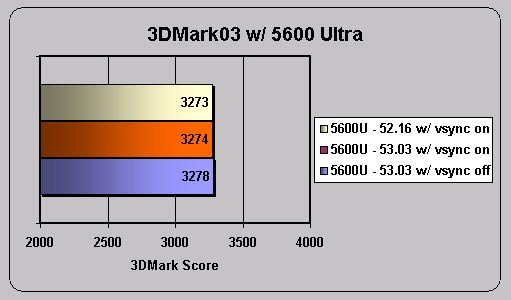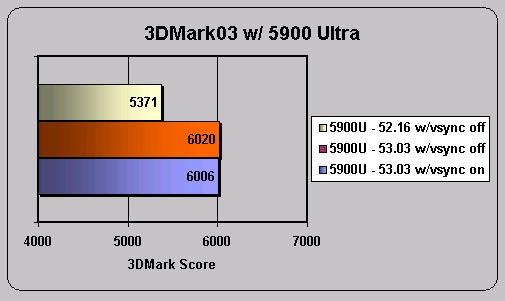nVidia and FutureMark’s 3DMark03
Test Setup:
- AMD Athlon FX-51
- ASUS SK8N
- Kingston PC-3200 Registered Memory
Video Cards Tested:
- Chaintech GeForce FX 5600 Ultra – 128mb
- nVidia Reference 5900 Ultra – 256mb
On the graph you will see that Vertical Sync was also tested. We included the test with Vertical Sync on in order to lay to rest the theory that V-Sync was one of the reasons for noticing a performance difference.
The Results:
5600 Ultra Results

As I mentioned on the previous page, we have noticed no performance difference on our 5600 Ultra between the 52.16 and 53.03 drivers. Take note that V-Sync had no effect on the results. When Adrian from Adrian’s Rojak Pot emailed FutureMark about this, Adrian received this in the reply:
“…with some display cards [the 53.03 display driver] does not fulfill the run rules. Please note that drivers may behave differently according to which display card they are used for.“
So it seems that the 5600 Ultra is not one of the cards that use the 3DMark03 optimizations nVidia has included in the 53.03 display driver. What about a 5900 Ultra?
5900 Ultra Results

Now we see the reason FutureMark asked us to remove our results using the 53.03 driver. The 5900 Ultra is a card which uses nVidia’s 3DMark03 optimizations and in return causes invalid results.
With some further research on the net, I have seen cases where GFFX 5200’s do not show a difference in 3DMark03 scores, and I have also seen cases on the net where GFFX 5950’s DO exhibit a difference in 3DMark03 scores. This observation leads me to believe that nVidia is purposely making their top of the line graphics cards look better than they really are in this benchmark. So not only is nVidia writing optimized code for 3DMark, but they are only doing it for certain graphics cards!
On to the conclusion where I will try to tie up all the loose ends!

Comments are closed.